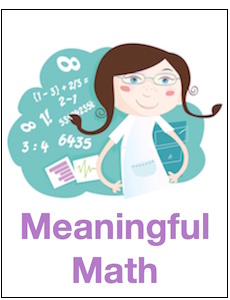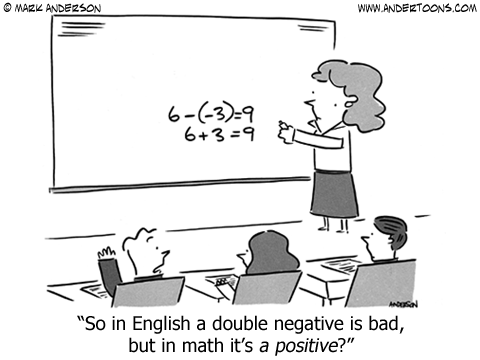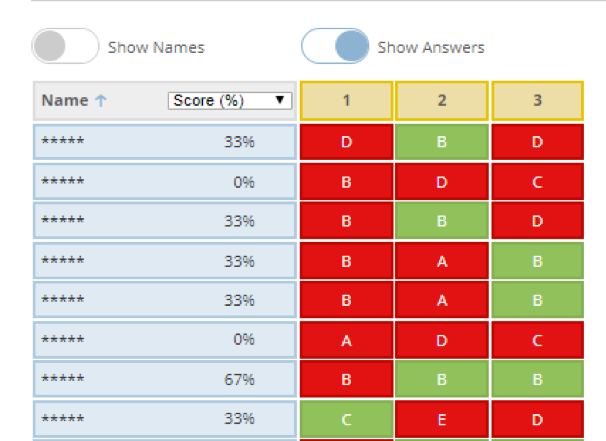Helping Kids See How Math Mistakes Can Help
A MiddleWeb Blog
 I have been giving a lot of thought to common math errors lately.
I have been giving a lot of thought to common math errors lately.
Our high school is judged on how well students perform on the ACT. To help them prepare, I have been giving ACT type multiple choice questions as bell ringers (warm-ups), and it has become very clear that my students are making some pretty common errors on a regular basis.
Unfortunately, the ACT (and other standardized tests) are structured to take advantage of those mistakes by including as one of the multiple choices common math errors that students are likely to make.
For instance, when asked to multiply (x + 2)2, I know that many of my students will think that x2 + 4 is the answer and that will usually be one of the answer choices (while x 2+4x + 4 is the correct answer).
There are many other common mistakes that I have noticed students making, such as graphing the slope of -1/2 as positive ½ because they go down 1 and left 2. Other errors are not fully distributing, making sign errors, etc.
I have been racking my brain for weeks — how can I reduce or prevent these common math mistakes? It finally dawned on me that I was looking at this the wrong way. Instead of asking how to prevent student mistakes, I should be asking “how can my students benefit from the mistakes they are making?” How can we leverage those mistakes and use them to improve? Whether you teach math in high school, middle school, or upper elementary, this is a question worth pursuing, I think.
Get Students Talking
I think one way that students can learn from their mistakes is by talking about them. However, it can be hard to get students involved in discussing their mistakes. What I am finding is that if I let a student who has the correct answer go to the board and explain their process, the other students are more willing to join in the conversation.
Of course, you have to pick a student who is willing and comfortable talking in the front of the class, but by this time of the school year, I know my students well enough to know which ones to ask. And I think other students are more comfortable “opening up” when one of their classmates is leading the discussion.
Sometimes during the course of the discussion, another student will voluntarily share the mistake they made, then others will pipe up and talk about how they did that too. It helps students feel better about their misstep when they realize other people have made that same mistake.
I’m finding that these student-led discussions allow students the time and the safe environment they need to really reflect on a mistake they made and learn from it. It can be a “growth mindset” experience.
There’s a Math App for That
Another way I have found to help encourage students to discuss their mistakes is by using the Socrative app. Socrative is a free digital tool that allows teachers to quickly administer quizzes and get feedback in real time.
This is an idea I read about it in a post featured on NCTM by Cathy Yenca titled, “Formative Feedback: The Way Digital Tools Are Used Can Make the Difference.” In the post she recommended using the Socrative app for “authentic error analysis.” Honestly, I haven’t thought to use it that way, but it is a great idea!
In my classroom, I will post a multiple-choice problem with some of the choices being those common math errors I know students will make. When the students respond, I can project their answers (anonymously) and the students can discuss the merits of each answer choice.
It’s a great way to get students talking, and it helps students discover the correct answer together. Again, it lets them see that others made that mistake and it’s not just them. There is a screenshot below of what it looks like.
Determine the “Kinds” of Mistakes That Are Being Made
In one of our department meetings a teacher talked about categorizing student mistakes as foundational or conceptual, and I thought that was an interesting idea. Obviously, students make mistakes for different reasons. I think it’s a good idea for students to reflect on their mistake and think about what caused it. Was it a concept they just didn’t know, did they get in a hurry, or did they misunderstand what was being asked?
I ran across a blog post at Teaching with a Mountain View, which also recommended dividing errors into two types: computational and conceptual. I like that! That’s certainly easy enough to understand.
Computational errors are those that happen when we are making our computations and we simply miscalculate. These are the math errors we typically make when we get in hurry, such as 23 = 6. Computational errors don’t have any bearing on whether we understand the math concept.
Conceptual errors are the ones we make when we don’t fully understand the concept. Identifying what kinds of mistakes they are making could help students know what to do next. If most of their errors are computational, they might just need to slow down or take advantage of their calculator. It could be an issue of nerves; many students make computational errors when they are nervous.
On the other hand, if a student is making conceptual errors, they may need to go back and review the material, get help from another student, or get some one-on-one help from me.
I have not had a chance to do this with my students yet, but after our next test we will definitely spend some time categorizing our mistakes as conceptual or computational. Then, when we begin entering full-on test prep mode in the spring, we will also be looking at categorizing our mistakes.
Convincing Students That Mistakes Can be A Good Thing
It can be a hard sell to convince students that mistakes can actually be a good thing, especially since they are punished mercilessly on standardized testing for every single mistake. Also, let’s be honest, making a mistake can be embarrassing.
But mistakes can be the best way to make progress. I’ve never learned anything worthwhile without making mistakes along the way. For my students, I need to rebrand mistakes as a necessary part of learning and progress. So hopefully breaking down our math missteps can smooth out the path to achievement!
Resources
Formative Feedback: The Way Digital Tools Are Used Can Make the Difference by Cathy Yenca
3 Types of Math Errors and How to Prevent Them at Math Geek Mama
The Power of a Good Mistake by Linda M. Gojak
Analyzing Math Errors: Conceptual vs. Computation Errors at Teaching with a Mountain View
Math Mistakes at The Glossary of Math Mistakes




































Helping students see that making mistakes is important and not always easy to do. A recent conversation with a teacher made me think more about helping students see that as Jo Boaler says “The very best time for brain growth is when you are struggling and making mistakes.” A couple of resources that come to mind are “My favorite NO” and “Don’t give a score, highlight mistakes” videos by Leah Alcala. Links to videos https://www.youtube.com/watch?v=srJWx7P6uLE and https://www.teachingchannel.org/video/math-test-grading-tips Another thought When taking a quiz or test have the students indicate for each question a C, S, or R for their feelings about the question. C = confident, S = Shaky or R = reteach please. When students complete the assessment they can go back at the end and look at questions marked S to see if anything during the assessment helped them remember how to do the problem.